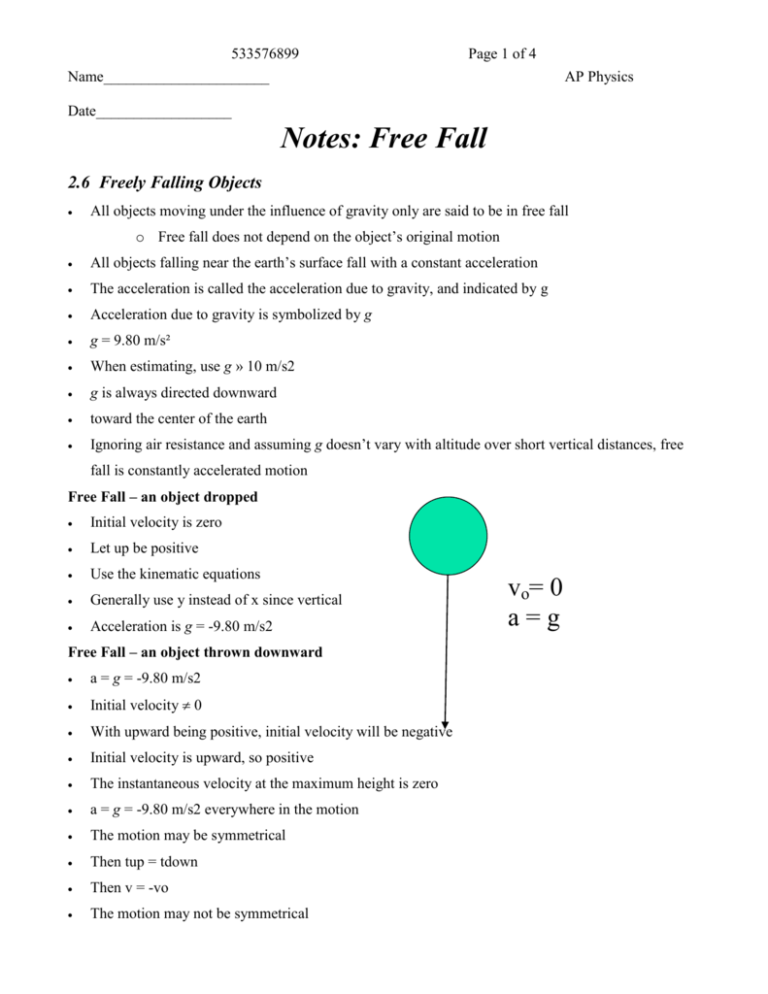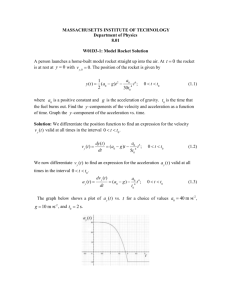Name
advertisement

533576899 Name______________________ Page 1 of 4 AP Physics Date__________________ Notes: Free Fall 2.6 Freely Falling Objects All objects moving under the influence of gravity only are said to be in free fall o Free fall does not depend on the object’s original motion All objects falling near the earth’s surface fall with a constant acceleration The acceleration is called the acceleration due to gravity, and indicated by g Acceleration due to gravity is symbolized by g g = 9.80 m/s² When estimating, use g » 10 m/s2 g is always directed downward toward the center of the earth Ignoring air resistance and assuming g doesn’t vary with altitude over short vertical distances, free fall is constantly accelerated motion Free Fall – an object dropped Initial velocity is zero Let up be positive Use the kinematic equations Generally use y instead of x since vertical Acceleration is g = -9.80 m/s2 Free Fall – an object thrown downward a = g = -9.80 m/s2 Initial velocity 0 With upward being positive, initial velocity will be negative Initial velocity is upward, so positive The instantaneous velocity at the maximum height is zero a = g = -9.80 m/s2 everywhere in the motion The motion may be symmetrical Then tup = tdown Then v = -vo The motion may not be symmetrical vo= 0 a=g 533576899 Break the motion into various parts Generally up and down Non-symmetrical Free Fall Need to divide the motion into segments Possibilities include Upward and downward portions The symmetrical portion back to the release point and then the non-symmetrical portion Quick Quiz 2.6: A tennis player on serve tosses a ball straight up. While the ball is in free fall, does its acceleration a. increase b. decrease c. increase and then decrease d. decrease and then increase e. remain constant Quick Quiz 2.7: As the tennis ball travels through the air, its speed a. increases and then decreases b. decreases c. decreases and then increases d. increases then decreases e. remains the same Quick Quiz 2.8: A skydiver jumps out of a hovering helicopter. A few seconds later another skydiver jumps out, so they both fall along the same vertical line relative to the helicopter. Both sky divers fall with the same acceleration. Does the vertical distance between them a. increase b. decrease c. stay the same Does the difference in their velocities a. increase b. decrease c. stay the same Page 2 of 4 533576899 Page 3 of 4 Example 2.8: A golf ball is released from rest at the top of a very tall building. Neglecting air resistance, calculate the position and velocity of the ball after 1.00 s, 2.00 s and 3.00 s. Example 2.9 A stone is thrown from the top of a building with an initial velocity of 20.0 m/s straight upward, at an initial height of 50.0 m above the ground. The stone just misses the edge of the roof on its way down, as showin in the diagram. Determine: a. the time needed for the stone to reach its maximum height b. the maximum height c. the time needed for the stone to return to the height from which it was thrown and the velocity of the stone at that instant d. the time needed for the stone to reach the ground and e. the velocity and position of the stone at t = 5.00 s 533576899 Page 4 of 4 Example 2.10 A rocket moves straight upward, starting from rest with an acceleration of 29.4 m/s2. It runs out of fuel at the end of 4.00 s and continues to coast upward, reaching a maximum height before falling back to Earth a. Find the rocket’s velocity and position at the end of 4.00 s b. Find the maximum height the rocket reaches c. Find the velocity the instant before the rocket crashes on the ground







